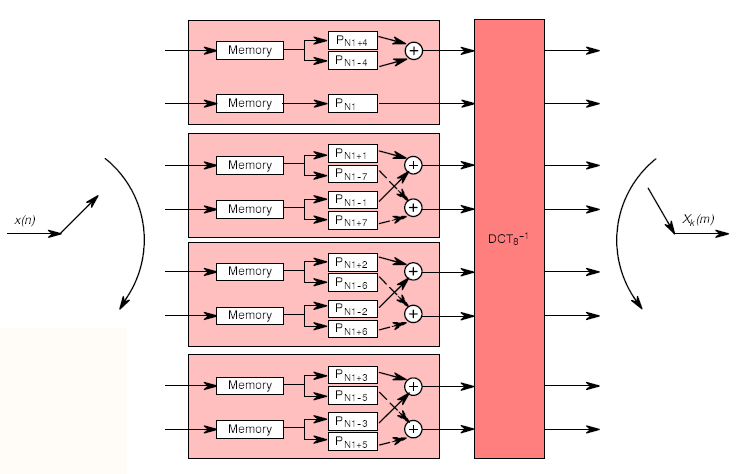Difference between revisions of "DTS Coherent Acoustics encoder"
(→The Quadrature Mirror Filter (QMF)) |
|||
| Line 14: | Line 14: | ||
== The Quadrature Mirror Filter (QMF) == | == The Quadrature Mirror Filter (QMF) == | ||
| − | The quadrature mirror filter or QMF filter is a set of filters, which complements each other to filter a frequency range into a number of subsets. After recomposition, the result reconstructs or closely reconstructs the original. The most effective way to do the required 32 band QMF is by using a FFT or Fast Fourier Transformation. The | + | The quadrature mirror filter or QMF filter is a set of filters, which complements each other to filter a frequency range into a number of subsets. After recomposition, the result reconstructs or closely reconstructs the original. The most effective way to do the required 32 band QMF is by using a FFT or Fast Fourier Transformation. The process begins by rearranging the samples in order to obtain the complementing nature of the filter. After this process, an IDCT transformation is implemented with an FFT routine. In modern DSP processors, this FFT routine is greatly optimized and can be executed quite fast. |
[[File:QMF.PNG]] | [[File:QMF.PNG]] | ||
Revision as of 23:07, 8 August 2013
| Project: DTS Coherent Acoustics encoder | |
|---|---|
| Featured: | |
| State | Stalled |
| Members | Danny Witberg |
| GitHub | No GitHub project defined. Add your project here. |
| Description | Make my own DTS encoder |
| Picture | |
| No project picture! Fill in form Picture or Upload a jpeg here | |
This project descibes a possible hardware implementation of a DTS Coherent Acoustics Core Audio encoder. The DTS Coherent Acoustics coding system is used as a file format for playing multichannel digital audio, but also for transporting multichannel audio over a digital audio connection. It is frequently used as the preferred CODEC in movies on DVD, Bluray or downloadable format. The coding system offers an exsensible high quality compressed multichannel audio stream. The core stream has a maximum of 7 channels of fullband audio, with 1 low frequency effect channel, and a resolution of 24 bits and a sample rate of 48kHz. Apart from this core audio stream, an extended stream can be offered with additional channels and/or higher sampling rates. A decoder for the datastream must be able to decode the core stream, but decoding the extended is optional. This way, backwards compatibility is provided. The extended stream can contain up to 32 fullband channels, frequency extension for core audio streams as well as extended audio streams, and resolution enhancements for all channels up to lossless quality.
This project describes the hardware implementation of a core audio stream encoder, using an FPGA and Digital Signal Processors. It accepts up to 4 stereo SP/DIF digital audio connections, or a single ADAT multichannel stream, and converts it to the DTS compressed audio link. If you plan to use this project for anything other than personal education, you should ask DTS Inc. if you have to obtain a licence: http://www.dts.com/professionals/licensing.aspx
How the DTS Coherent Acoustics CODEC works
A fullband channel is compressed in various ways, but always begins by dividing the channel into 32 subbands by means of a quadrature mirror filter. After obtaining these 32 subbands, every subband can, but does not have to be, compressed with use of a adaptive differential method, also named ADPCM. This algorithm is used to send the difference that the signal has, compared to the previous sample, instead of the actual amplitude. In slow changing signals, low frequencies, this can be a very effective method to reduce the amplitude of the signal that has to be encoded. After this first step, linear scalar quantization is used to compress the amount of data that has to be transmitted. In other words, a clevery chosen lookup table is used to descibe the amplitude of the signal. After this quantization, the data may be further compressed by use of a huffman code. Finally, the remaining data is placed in the core audio stream.
The Quadrature Mirror Filter (QMF)
The quadrature mirror filter or QMF filter is a set of filters, which complements each other to filter a frequency range into a number of subsets. After recomposition, the result reconstructs or closely reconstructs the original. The most effective way to do the required 32 band QMF is by using a FFT or Fast Fourier Transformation. The process begins by rearranging the samples in order to obtain the complementing nature of the filter. After this process, an IDCT transformation is implemented with an FFT routine. In modern DSP processors, this FFT routine is greatly optimized and can be executed quite fast.
